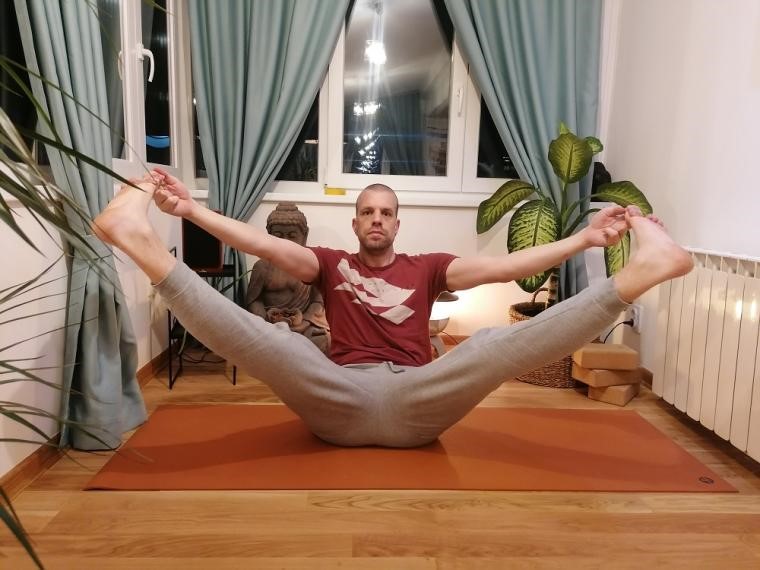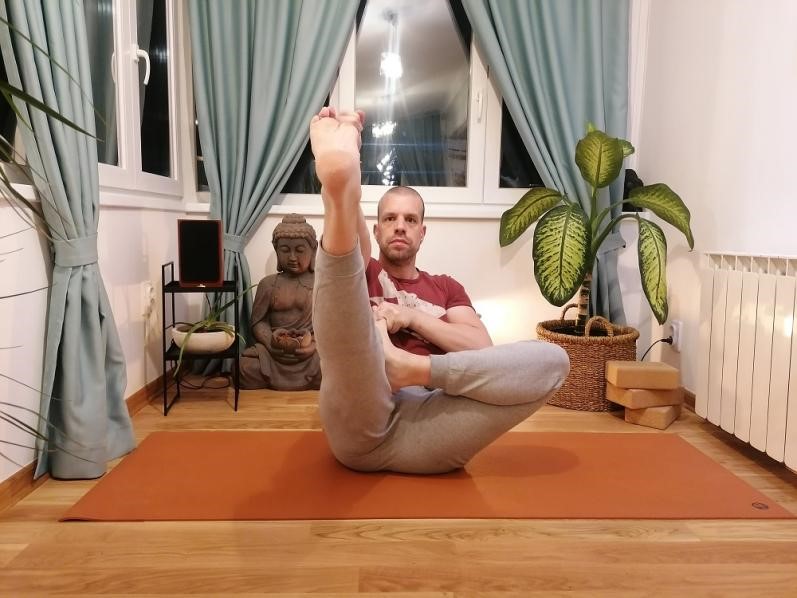The bear pose has two different names in Sanskrit. So, it is very common for people who have not had the opportunity to practice the same pose to be in doubt as to the exact name of this asana in Sanskrit.
Merudandasana is the first name; merudanda means “spine,” and asana means “pose.”
Upavistha Konasana B is another name for this pose. Upavistha means “sitting,” Kona means “angle,” and Asana means “pose.”
A DEEPER INSIGHT
A large number of poses in yoga have the names of animals for the simple reason that the body positions themselves that are associated with a certain animal or the movements within a certain position are equal to the movements of a certain animal.
Having that in mind, this pose is associated with a bear, which balances sitting with its legs raised and spread out to the side. Accordingly, this asana falls under the category of seated balances.
When it comes to the level of difficulty of the pose itself, it falls under the category of intermediate level poses. This asana affects the work of the sacral (Swadisthana) and root (Muladhara) chakras.
If you include this pose in your daily routine, your creative energy will certainly increase and you will be more satisfied and happier. It is also believed that by practicing this asana, you can influence abundance in your lives. The elements of this chakra are water and earth.
PRACTICE AND BENEFITS

Since this asana is a seated balance pose, it requires a strong core. Therefore, the abdominal and back muscles must be well developed if you want to perform this asana correctly.
Practitioners who have sciatica problems should do this pose. In some cases, if it is a more severe form of sciatica, this asana should not be practiced.
The same applies to practioners who have recently had injuries to the tailbone, hips, knees, chest, back, shoulders, or elbows. So, either do the pose with full attention or do not practice it at all.
My advice is that while practicing this pose, find your focal point, which will be one meter or one and a half meters in front of you. This point of focus does not have to be exclusively on the floor; it can also be at the level of your eyes. Some practitioners even find their focus point on the ceiling, i.e., stretch their neck upwards and find their balance.
Of course, if you want to fully perform this asana, your legs should be fully stretched. Groins, hamstrings, and calves should be finely stretched. Otherwise, you will not be able to fully do the pose itself. In that situation, the only option left for you is to vary the pose itself.
One variation involves keeping your legs bent at the knees if your legs are not fully extended. Accordingly, you will not be able to reach the toes with your fingers but you will reach the ankles, calves, and the position below the knees or thighs.
Another variation involves using a block or wall as a support for your lower back if you lose balance. In this way, you will be able to completely transfer your attention to the activity of the muscles of your stomach, back, and legs.
And yes, do not forget to use mula and uddiyana bandha (muscle contractions).
If you are ready to perform the full pose, you can enter it from the butterfly pose. You can spend between ten and twenty inhalations and exhalations in it. While in the butterfly pose, grasp your toes with your fingers and find your focal point. Inhale once and exhale once in this pose. With an inhale, slowly lift and spread your legs to the side. Try to keep your back completely straight. This certainly involves leaning back slightly. The full pose means that your legs are fully extended to the side. If you feel you can, try to stay in the pose with your eyes closed. In this way, you further develop your inner sense of balance.
In a situation where you have successfully performed the full pose, you can try variations of this asana. Variations that are practiced only in situations where the full pose is performed correctly.
The first variation implies that the right leg is fully stretched forward and at least 45 degrees, while the left foot is on the inside of the right thigh or completely descends on the right thigh. That same pose, only with the left leg extended and the right foot next to or on the left thigh.

Another variation involves both legs being stretched forward and raised to at least 45 degrees, with the heels together. In this variation, it is very important that the back is fully stretched and that both bandhas are active.
This asana strengthens the lower back, shoulders, and arms while stretching the legs (calf muscles, hamstrings, groin, back) and opening the hips and pelvis. During the performance of this pose, the chest opens and the heart chakra is activated. The breathing deepens as you stay in this pose. The organs of the abdominal cavity are massaged, which greatly affects the work of the digestive organs.
Therefore, if you have problems with your digestive organs, the Bear Pose can help you solve them. Practitioners who are facing the problem of kyphosis or similar back problems can benefit greatly from this asana.
CONCLUSION
If you are currently unable to fully do bear pose because your legs are not stretched enough, your hips are not open enough, or your back and stomach muscles are not strong enough to hold you in the pose, I advise you to address those segments of your body first.
It is very important that you become aware of which part of your body is currently preventing you from further progress. Only in this way will you be able to focus on your further progress when it comes to your yoga practice.
Some of the basic postures that yoga teachers are advised to practice before doing bear pose itself are: Dandasana, Janushirasasana, Paschimottanasana, and Uttanapadasana.
Practicing this poses will strengthen your core first and foremost. You will also strengthen your back muscles and improve the mobility and flexibility of your entire body.
Namaste.







